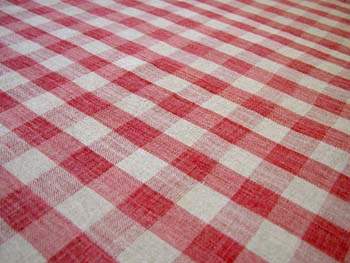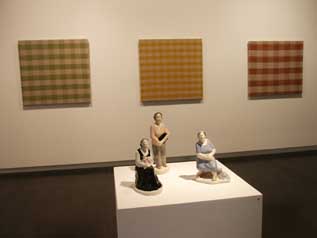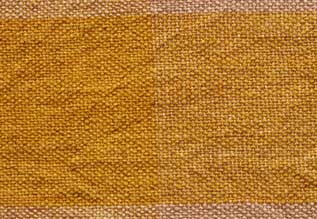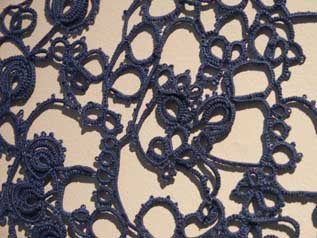
|
||
|
Portland art blog + news + exhibition reviews + galleries + contemporary northwest art
|
||
Hildur Bjarnadottir at Pulliam Deffenbaugh  Hildur Bjarnadottir - Gingham - Cadmium Red Icelandic artist Hildur Bjarnadottir doesn't ignore art and intellectual history; she gives it a newer, smarter, better made/time tested and reflexively subversive cloth to wrap it in. She has already received kudos from Art in America and Artnet but her latest show, Overlap at Pulliam Deffenbaugh Gallery shows her as the fully developed, unpatronizing and supremely deft contemporary virtuoso her earlier and more obvious work had always pointed towards. Somewhere between Modernism's impulse to push beyond the mundane and Duchamp's brilliant "so what" mundane ready-mades (later restated in Pop art), traditions became unfashionable. Simply put, making things as a "practitioner of craft" was so out by the heyday of Jeff Koons. Fabrication was simply something to be subcontracted out. (Really there is nothing wrong with that as long as the inverse was allowed as well) Yet, by 1987 or so it became an intellectual no no to form a deep personal connection to the past through practicing a craft. Carrying on a tradition somehow was perceived as soft headed as some (Fukuyama, Derrida, and Deleuze) debated the end of history... as if all connection to the past had been shattered and no further paradigm shifts could occur. Some intellectual end game? Hilarious! In fact, tradition is now back with a vengeance and oh my what sharp teeth you have Grandma. One can see it everywhere; moralizing fairytales, religious fundamentalism and handicrafts have all become big time cultural discussion points (and pastimes) if one takes The Lord of the Rings, Titanic, the Bush Presidency/Al Qaeda, and the knitting/embroidery craze into account. In the art world, Tracey Emin, Rosemarie Trockel, Tom Friedman, Yayoi Kusama, Martin Puryear, Ken Price and the preeminence of Louise Bourgeois/Agnes Martin all have brought obsessive craft back, utilizing its inherent personal vulnerability and relentless process, while often imbuing it with the properties of a rigorous intellectual jungle gym. You can see an attempt at this in the current work of Sarah Sze, Phoebe Washburn, Jim Drain, Tim Hawkinson and Roxy Paine to name a few. Some lazyheaded types call the trend post-conceptual but it is an invested attempt at continuity in culture (even if that lowest common denominator is literally garbage being reorganized as installation art). By such reinvigorated connecting, traditions can be summoned and adapted to effect the present by making a host of stock assumptions very suspect. 
To that list of continuity artists lets enter Icelandic artist (and onetime Portlander) Hildur Bjarnadottir. Her latest show in Portland (a city which has had craft night at bars for years) continues to blur the old fashioned with wry, very relevant assumption busting. The first thing one is struck with is the oblique, detailed and unpatronizing display of the show, rather Dia-like with three woven paintings (each just slightly smaller than its neighbor) foregrounded by porcelain figurines. In these rather nuance free times it's a joy to encounter the familiar gingham patterns displayed so boldly with little explanation. One wonders if they are paintings, ready-mades etc? all the while feeling like its about time to break the picnic basket out. It turns out the works are all woven on a hand loom but like a bunch or woven Fred Sandbacks, Bjarnadottir has hand died the pattern into the yarn, one string at a time.  Gingham (detail) Up close the effects are expansive and orienting like some sort of civilization building compass. The nuanced variances in the surface are so fine Martha Stuart might go apoplectic trying to get the thread count. It works as both formalist and dadaist while being folky, questioning the various terms and attendant epistemologies, dogmas etc. The objects by invoking tradition also bring to mind an invisible army of similar practitioners. Be they mechanized factories or solitary craftspersons, they are all committed to the task of making more gingham, like some lo-fi version of the Borg hive. Humans are nothing if not industrious and I like how this show differs from her pervious Pulliam Deffenbaugh show "extending canvas" which embroidered words like "painting is the only true art form" onto linen. This new work goes beyond discreet art-world polemics and gets at personal and cultural habits. 
Doodling (detail) One of my favorite pieces in the show is "Doodling", many people and a huge percentage of the artists I've met doodle all the time, often with a cheap blue ball point pen. Bjarnadottir takes this activity and morphs it into a whimsical tatted yarn lace doily died blue with ballpoint pen ink. It would be mostly just an academic stunt if it weren't executed during a series of long family phone calls. We have all been there and Bjarnadottir acts as some kind of domestic alchemist imbuing the inevitable and often boring with wonder. Yes, skill and a little sharp thinking can lead to good things. To further stretch the idea of authorship, craft and art Bjarnadottir took a series of found doilies and saturated them with graphite, somewhat reverse engineering her doodle work. She turns found objects into drawing sculptures that pervert both the traditionalness of the ready-mades and the tradtionalness of drawing with a pencil. They look amazing, yet the eye has trouble ascertaining exactly what is going on in the way that most handicrafts can be seen as a record of their making.  Lassoing (video still) The show gets really aggressive with the "pervert conceptually to honor tradition" theme with the "Lassoing" video. In it cowboy craft revivalist extraordinaire Roy Rodgers rides full gallop while concurrently circling the horse with a lasso. Bjarnadottir considers it performative textile art yet it relates to the films of Warhol and Fischl and Weiss. Of course it looks like art so it is and it does involve a pop icon along with twirling string so we have to consider it textile art for the very open-minded. It makes this point successfully because of the skill and materials are given a little more amplitude in comparison to its stock state as stunt oriented entertainment footage. Still pop, still craft this video and the rest of this show are related to Merret Oppenheim's subversive appropriations. The difference is how Bjarnadottir usually but doesn't always appropriate/hijack her own handiwork. In Filippery II, the artist creates Trompe l'Oeil pieces of moss made of velvet pile on top of a vintage tablecloth. Is it desecrating the tradition or reinvigorating it? I've always found it interesting when a virtuoso only has pride in the effect, not the practice and Bjarnadottir certainly falls into that category. Still what is most telling is how she created porcelain figurines of her three grandmothers as objects to venerate. Technically one really can't have three grandmothers but once again Bjarnadottir is messing with us (one is probably a great grandmother). These apparently are the women responsible for teaching her these traditional crafts which she is both practicing and updating as a living tradition. In Norse mythology there are three fates (Norns) that she may be referencing here as well. Leave it to an artist to utilize traditional handicrafts to both invoke and modify fate. Unlike a jazz traditionalist like Wynton Marsalis, Bjarnadottir breaks tradition to save it. She ignores the domestic rules and pollutes contemporary tropes as fast as she can find them and if that isn't a way to confoundingly invigorate contemporary art and traditional roots I don't know what is. A lesser artist would have stooped to text and more heavy handed connections, here only the flawless presentation and execution of the work is tight. The implications and effects are expansive. I simply can't look at ball point pens, doilies, tablecloths and Roy Rodgers the same way again. It seems like anything is possible with talent and an open mind. I suggest that she could knit a shroud for Derrida and call it "Acts of Literature." If one accepts tradition as open to change, suddenly the fragmentation of history and experience isn't so overwhelming because talent can exist to reflexively subvert and reestablish itself. Talent is that which survives the autopsy of deconstruction (or is that just another word for critique). In this case Bjarnadottir has that elusive "it" in spades and merely needs a high profile project to make that point even more perfectly clear. Till then, this is one hot show. *note Bjarnadottir has a concurrent show up at the Boise Art Museum until March 12th. Posted by Jeff Jahn on January 25, 2006 at 0:07 | Comments (5) Comments Jeff. Just AMAZING depth here. You hit it dead on. I am so loving Hildur's work, and you demystified something for me, and not in a way that even slightly deters my ongoing interest. I also have to say that the hand in the stitch can be currently seen in the works by Sophie Calle at the PAM, and of course in the beautiful multiple by Ann Hamilton (one of my three muses..Duchamp and Beuys being the others, of course) up at Greg Kucera's. And, if you haven't already been, I would be open to a field trip up to Boise!!!! - TJ Posted by: TJ Norris I agree this is a great review! Interesting connections to mythology as well as Derrida and deconstruction theory... And funny too! The Gingham Borg thing really made me laugh... (My staff has just left a note on my desk which says "How many times do we have to tell you, art criticism isn't supposed to be funny?" but whatever...) Wait, are we allowed to compliment our own writers? well, it is a Blog.... Posted by: Isaac Thanks, I simply try to do the artwork a bit of justice and when the artwork is good it's a lot easier to write a good review. Hildur deserves the credit here of course. Also,readers thanks for all the nice private emails. One thing I'm trying to do is develop a more conversational style of writing for the web while weaving in a lot of high brow content that remains acessible. Posted by: Double J For some reason, I just didn't get overly excited for this show. I thought the pieces were clever and well planned. "Doodle" was especially amazing. I would almost love to see just a whole show of that. That piece was really powerful. I think it was all great art and a successful show, but this is just my opinion (which I know means virtually nothing), I just didn't really care for it. I now await a mob with pitchforks outside my front door. Posted by: Calvin Carl Oops, I called it "Doodle" when it was "Doodling." Posted by: Calvin Carl Post a comment Thanks for signing in, . Now you can comment. (sign out)
(If you haven't left a comment here before, you may need to be approved by
the site owner before your comment will appear. Until then, it won't appear
on the entry. Thanks for waiting.)
|
| s p o n s o r s |
 |
 |
 |
 |
 |
 |
 |
 |
 |
 |
 |
 |
 |
 |

|
Site Design: Jennifer Armbrust | • | Site Development: Philippe Blanc & Katherine Bovee | |


![[TypeKey Profile Page]](http://www.portlandart.net/nav-commenters.gif)